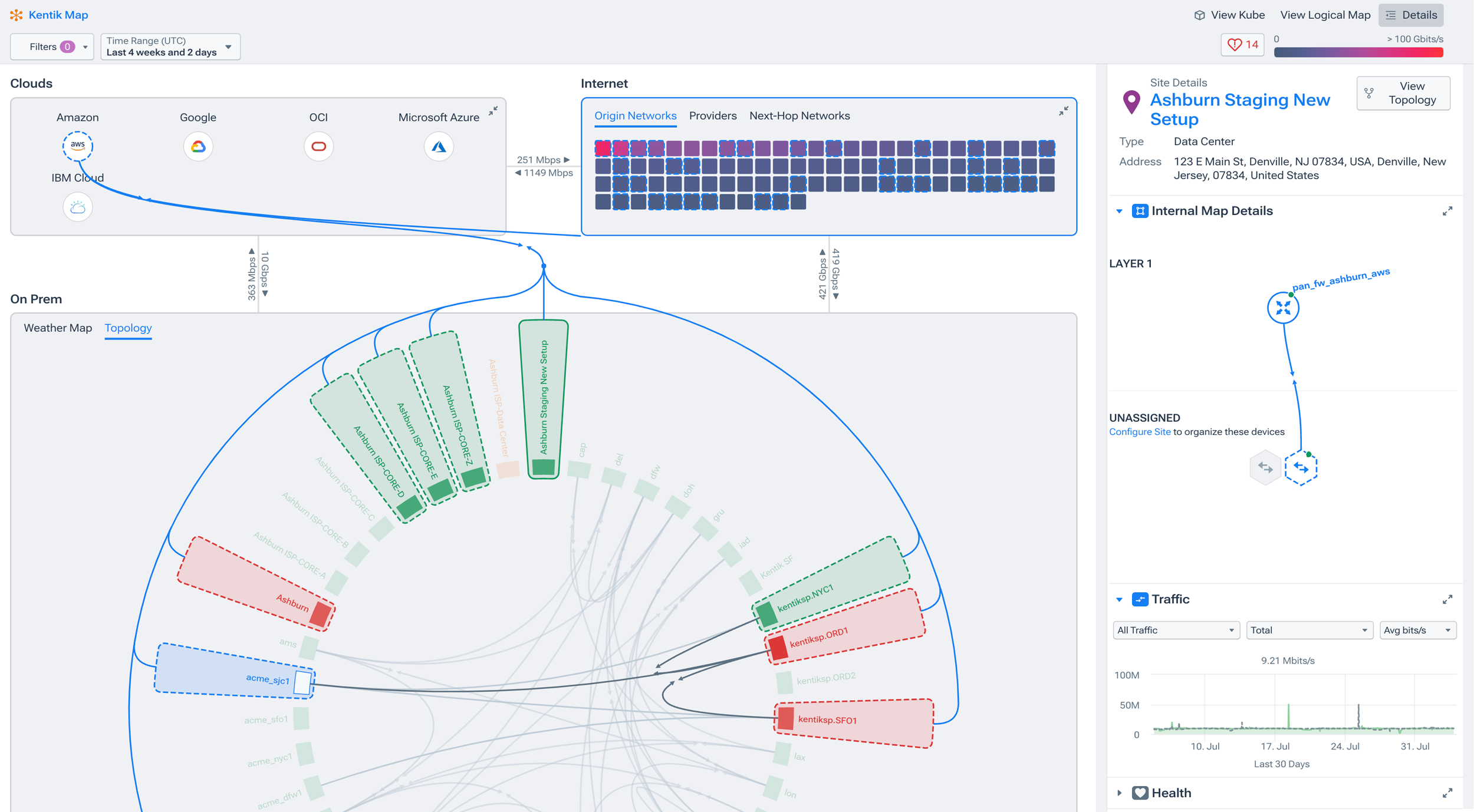What Is a Network Map? A Guide to Building and Maintaining Network Maps
A network map serves as a visual blueprint of your network’s topology, showing you how different nodes connect and interact. This knowledge aids in effective network management and enhances troubleshooting and security measures.
In this article, you’ll learn all about what a network map is and how you can go about building and maintaining your own network maps.
What Is a Network Map?
A network map is a visual representation of a network’s physical and logical layout. It shows how various devices, such as routers, switches, servers, and other nodes, are interconnected. Network maps can also depict the flow of data within the network, helping administrators understand how different parts of the network interact.
Key Features of a Network Map
- Nodes and Connections: Displays all devices in the network and their interconnections.
- Topology Details: Provides insights into both physical (wiring, devices) and logical (VLANs, subnets) topologies.
- Real-time Updates: Reflects the current state of the network, including any changes or new additions.
- Interactive Elements: Allows for zooming, clicking on nodes for details, and other interactive features for deeper analysis.
Having a network map is crucial for effective network management, troubleshooting, and security. It provides a comprehensive overview of the network’s structure and helps in identifying issues, optimizing resources, and planning for future expansions.

Why Do You Need a Network Map?
Having a solid grasp of network mapping is vital for any NetOps professional since it offers many compelling benefits, including the following:
- Network maps enable resource optimization by identifying underutilized devices or bandwidth bottlenecks. For instance, they can reveal that a server is overloaded while another is idle, prompting load-balancing adjustments to distribute network traffic more efficiently.
- Network maps streamline troubleshooting and diagnostics by pinpointing the location of faults and, thus, helping in root cause identification. For example, if a segment of your network goes down, the map quickly reveals the affected nodes and connections, enabling you to isolate the issue and apply targeted fixes without disrupting unaffected areas and reducing downtime.
- Network maps aid in security management, making it easier to spot unusual connections that could indicate breaches. For instance, if an unauthorized device appears on the map, you can quickly investigate and address the intrusion. This bolsters your network’s defense against unauthorized access and potential threats.
- Network maps help to accelerate the disaster recovery process. For instance, if a server fails, the map shows its network relationships. This allows you to quickly reroute traffic to backup systems and minimize service interruption.
Now that you know why you should use a network map, let’s learn how to build and maintain one.
Step-by-Step Guide to Building Your Network Map
The following are the steps you need to take to build your own network map:
Collect Inventory
Start by gathering a complete inventory of all network-connected devices, including routers, switches, firewalls, servers, wireless access points, modems, load balancers, network-attached storage devices (NAS), and even uninterruptible power supplies (UPS), and security devices, such as CCTV cameras. It’s also a good idea to inventory your virtual machines and other virtual instances, such as virtual switches, routers, firewalls, load balancers, network function virtualization (NFV) components, and software-defined wide area network (SD-WAN) devices. By doing so, you’ll improve the visibility of your virtualized environments, which helps you understand how VMs and other virtual components interact with physical devices and other virtual instances when you build the actual network map.
This stage aims to have a clear idea of what devices, whether physical or virtual, are present on your network before you start mapping their connections and relationships.
Since inventory collection lays the foundation for your network map, it’s recommended that you utilize automation tools whenever possible, as manual inventory collection can be time-consuming and prone to human errors, especially in dynamic environments. Generally, these tools rely on protocols, such as the simple network management protocol (SNMP), to streamline the auto-discovery process. This significantly reduces the time and effort required to collect network inventory data. These tools can also automatically update inventory lists in real time and help create a network map with minimal manual intervention.
Use Automated Network Mapping Tools
Automated network mapping tools are helpful when tackling the intricacies of topology discovery, which is essential for understanding the interconnectivity of devices within your network. Their ability to swiftly and accurately map out network segments, such as virtual local area networks (VLANs) and virtual private clouds (VPCs), is particularly beneficial in intricate configurations, such as hybrid cloud environments, where traditional mapping approaches often struggle to keep pace with the dynamic nature of such networks.
Simply put, automated network mapping tools excel by providing real-time visibility and insights, making them indispensable for network administrators who need to maintain an up-to-date view of their network’s topology.
Kentik, a leading network observability tool, can collect, derive, and correlate network traffic data, including flow records, Border Gateway Protocol (BGP), GeoIP, and SNMP, from routers, switches, and hosts. It can also collect data from resources hosted by cloud service providers, such as Amazon Web Services (AWS), Google Cloud, and Azure. You can consolidate network telemetry insights from on-premises, hybrid, and cloud infrastructures within a single interface, streamlining the analysis process and, thus, providing you with total network observability, which is crucial for mapping your network.
Document Device Details
Alongside mapping, documenting specific network device details, such as Medium Access Control (MAC) addresses, hostnames, device types, and manufacturers, is equally important. This level of documentation provides a comprehensive inventory, allowing for precise identification and efficient management of each network component.
Detailed records also facilitate streamlined troubleshooting, enhance network security by enabling administrators to spot unauthorized devices quickly, and ensure compatibility across the network infrastructure. In addition, such thorough documentation supports optimized network performance and simplifies both asset management and compliance with IT standards. Automation tools like Kentik are also helpful, as all registered devices can be listed effortlessly.
Create Multiple Network Layers
Creating a multilayered network map is a strategic approach to managing the complexity of extensive or intricate network architectures. It helps avoid the pitfalls of a single map that can be challenging to decipher and use effectively.
When you segment the map into distinct levels, each focusing on a specific area, you achieve a more organized visualization. The first layer could detail physical wiring and devices, such as routers, switches, and firewalls, providing a clear view of the tangible infrastructure. The second layer could show the virtualized aspects, like VLANs and overlay networks, illustrating how resources are pooled and segmented. The third could depict application connectivity, showing how software components communicate across the network.
This kind of segmentation simplifies troubleshooting as you can quickly isolate issues within a particular layer. It also enhances planning and scalability by allowing you to focus on one aspect of the network without getting overwhelmed by unrelated details. For example, when upgrading your physical hardware, you can reference the relevant layer without sifting through virtual or application-level information.
Tools like Kentik enable you to take the multilayer approach to the next level by grouping network devices using labels and, therefore, reference a collection of devices by function, region, client, application, and so forth.
Following the steps described here, you can build a comprehensive and dynamic network map. This map not only aids in day-to-day network management but also becomes an invaluable resource for strategic planning. That said, a well-constructed network map is not a static document but a living entity that evolves with your network; that’s why maintaining it is also an essential part of the process.
Best Practices for Maintaining Your Network Map
Maintaining an accurate and up-to-date network map is as important as creating one. It ensures that your network management activities are based on current information, enhancing efficiency and security. Let’s take a look at some of the best practices you can implement to help maintain your network map.
Integrate with Change Management
Any changes to your network infrastructure should be promptly reflected in your network map. This ensures that the map accurately represents your current network state and helps avoid discrepancies that could lead to inefficiencies or security risks.
Use Network Monitoring Tools
Integrating your network map with network monitoring tools can significantly enhance your visibility into the network. It’s a powerful combination that not only keeps your network map current but also leverages its insights for operational excellence.
For instance, Kentik’s telemetry capabilities let your team visualize all network traffic, making it a top choice for advanced network monitoring and observability.
Conduct Regular Audits
Regular audits are crucial for maintaining the integrity of your network map. Start by verifying the accuracy of device information, then check for any discrepancies between the map and the actual network setup. Update any outdated or incorrect information as necessary to ensure your map accurately reflects the network’s current state.
Regular audits help identify potential security vulnerabilities, optimize network performance, and facilitate efficient capacity planning.
Document Changes and Foster Communication
Maintaining a detailed change log is essential. Document any configuration modifications, device replacements, or network expansions. This log provides a historical record of network changes, assisting in troubleshooting and future network planning, and adds another layer of detail to your network map.
Additionally, discussing network changes during regular meetings ensures that all team members are aware of updates, can address discrepancies, and have access to the most current version of the network map. Collaboration ensures that the maintenance process is efficient and that the network map remains reliable for everyone involved.
By adhering to these best practices and steps, you ensure that your network map is a dynamic tool that reflects the real-time state of your network.
Conclusion and How Kentik Can Help
A well-maintained network map is a cornerstone of effective network management, helping you confidently navigate the complexities of modern network environments. In this article, you learned all about network maps, including how to create and maintain one.
If you’re interested in creating a network map, consider Kentik. The Kentik Network Intelligence Platform offers a modern, SaaS-based approach to network topology visualization and troubleshooting for today’s hybrid and multicloud networks. Start a free trial or request a demo to try it yourself.


